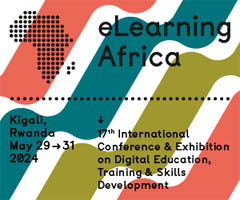Elearning 2.0 - A Stepping Stone to Elearning 3.0?
 Grenaa (DK), November 2007 - Anne Fox is teacher trainer in the Experience-Based Learning Project, a Danish project piloting teacher training in the adoption of web 2.0 tools in secondary education. For CHECK.point eLearning, she reveals her findings and gives advice to other teacher trainers.
Grenaa (DK), November 2007 - Anne Fox is teacher trainer in the Experience-Based Learning Project, a Danish project piloting teacher training in the adoption of web 2.0 tools in secondary education. For CHECK.point eLearning, she reveals her findings and gives advice to other teacher trainers.
Could you please give us a brief overview on the Experience-Based Learning Project?
Anne Fox: This social fund project is designed to disseminate more experiential methods of learning in the belief that learning is longer term and deeper when acquired through concrete experiences than through traditional transmission methods, which are still very prevalent. Although experience-based learning has a long and illustrious history and need not imply the use of ICT, the fastest growing potential to apply experience-based learning is by using ICT tools, especially those Web 2.0 tools requiring little financial or time investment.
The EBL project is aimed primarily at the education sector from local schools up to university level but also seeks to transfer good practices into the business training sector. The reason for targeting effective learning methods is that the project promoter, Djurlslands Erhvervsråd (Djursland's Business Advisory Service) is located in a peripheral, rural area of Denmark and sees better quality education as an important way of retaining and attracting professional people to settle in an area that could otherwise suffer from depopulation.
We cannot ignore the explosion of cheap and ubiquitous computing and electronic communication, which greatly extends the possibilities of promoting authentic experiences in education and training. Therefore many of the approaches promoted by the EBL project are based on the integration of ICT tools.
We negotiate with institutions to offer tailored "intro days" for their staff during which they are introduced to topics such as video-based learning, story-telling techniques, the use of animation, and Web 2.0 tools such as wikis, blogs, and podcasts. Participants then decide which topics they would like to try out, and we offer tailored training and support, including classroom support, to trial the new approach with their students.
The EBL project has also helped local organizations get started with specific tasks such as setting up a discussion group with shared editable documents or setting up a video blog for a local tourist attraction.
How easy or how difficult is it for teachers to adopt Web 2.0 tools in upper secondary education?
Anne Fox: It is often difficult. Teachers themselves will present many objections, but I think that the key is at the individual institutional management level. School leaders are the link between government exhortations to integrate ICT and the teachers. Head teachers need to ensure that internet-enabled devices are widely available and that teachers are frequently updated on their ICT skills with regular, preferably informal or just-in-time training.
However the biggest disconnect is caused by the implied change of role of the teacher from "sage on the stage" to "guide by the side", which, if not explicitly addressed, leads to great anxiety and feelings of insecurity that can be expressed in the following ways:
- Teachers' major concerns are securing more resources such as up-to-date books and more time to do their jobs. Salaries, too, are currently much in focus. It is difficult to put Web 2.0 tools on the agenda.
- Many teachers use the internet as a source of information but hardly any use it as a source of interaction. Of those who have an idea about what Web 2.0 is, many have a negative perception of it as untrustworthy because it is being created by amateurs, such as Wikipedia. Other criticisms are that it is a way of wasting time in chat or social networking sites such as Facebook or that it actually promotes unethical behavior by enabling and facilitating the illegal exchange of music files.
- Without continuous training there are many technophobes because the technological leap necessary becomes too great. There are, therefore, many who see the use of Web 2.0 tools as terribly difficult and complicated, even though we try to advocate only low-threshold applications. These are free to use, can usually be set up after only a few clicks, and can easily be abandoned if they do not suit.
- There are many who cite the heavy demands of the upper-secondary curriculum as a reason not to experiment.
- For those who might be willing to try, the initial time investment is seen as a major barrier.
- Where there is an existing LMS, it may not be clear what role Web 2.0 tools could play. Their strength in making contact with the outside world needs to be emphasized in this case.
The breakthrough comes when people are willing to try it out on their students. At that point the benefit becomes clear, but it will only be followed up if the school ICT and philosophical infrastructure makes it easy to implement. So even though the EBL project offers classroom support, it is only the tiniest minority who take up that offer.
How important are mentoring schemes within educational institutions?
Anne Fox: Absolutely crucial. We come in as fleeting guests and quickly leave again. This is the case even though the EBL project runs a blog and a wiki that all participants are invited to use. However, because these are Web 2.0, tools, they are not widely taken up.
Mentoring is not part of this project, but our experience in this project has led us to apply for a new project, VITAE, designed specifically to set up educational mentoring schemes. We can see that the more time we spend with people, the higher the chance we have that they will be willing to experiment and adopt.
A mentoring system would also model the "guide-by-the-side" approach, which we think is the educational approach of the future. Mentors would also more easily be able to implement drip-feed, just-in-time learning, which is most effective in promoting the adoption of Web 2.0 tools in classroom practice.
But equally important is the support of management. There are Web 2.0 trail blazers all over the world, but they often work alone and have little influence on their colleagues unless management recognizes and backs them up. Management support is needed to validate and organize a mentoring system and to make sure that the technical backup to run Web 2.0 tools is in place.
When does eLearning 2.0 lead successfully towards eLearning 3.0?
Anne Fox: eLearning 2.0 is about using Web 2.0 tools in teaching. It often implies a great deal of effort on the part of the teacher to set up blogs, wikis, and so on as well as setting up the networks that their students will use to communicate with others. ELearning 3.0 will happen when learners take on much more of the responsibility for setting up their own blogs, wikis, and podcasts and for creating and nurturing their own networks. This implies a seismic shift in the role of the teacher to that of facilitator and that learners' responsibility for their own learning becomes more than a slogan. Perhaps eLearning 3.0 will happen when we drop the "e" altogether because ICT will have become as integrated into education as, for example, electricity is today.
What lessons can other teacher trainers learn from your project?
Anne Fox: You need lots of examples that are closely linked to the timetable of the teacher participants. I have had the experience of showing a mathematics blog and being challenged by a chemistry teacher that this had had nothing to offer him in his subject. Therefore, the more targeted the better.
You need to encourage teachers to try this out with their students instead of just talking about it in an abstract way. Only then will they appreciate the sheer wonder on the faces of their students when they realize that this wasn't just another piece of homework but that somebody else actually wanted to read, listen to, or watch their work.
I have worked with these tools for many years and keep wondering when the students in my class are going to think that this is just routine. But young people are not as tech-savvy as the mass media would have us believe, and their networks, whether nurtured digitally or face to face, tend to be parochial and age-limited.
You need to show the potential of Web 2.0 tools both in the existing paradigm, e.g. blogs as a classroom notice board, and as part of visionary futures, e.g. blogs as part of a personal learning network. There are examples starting in many different countries where schools have been set up based on current knowledge of learning processes, such as the Met schools in the US, Slash21 in the Netherlands, and Stovner Vidergåendeskole, in Norway. These institutions hardly mention ICT, but it is the bedrock on which they are built.
Frequent, small-scale, classroom-based professional development activities are more effective than impressive, pyrotechnical demonstrations.









